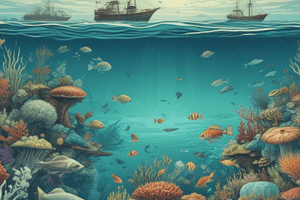Podcast
Questions and Answers
Which organisms are part of the biotic components of marine ecosystems?
Which organisms are part of the biotic components of marine ecosystems?
- Marine debris and plastic waste
- Seaweed and coral reefs
- Rocks and sand
- Phytoplankton and macroalgae (correct)
What are the physical components of marine ecosystems?
What are the physical components of marine ecosystems?
- Salinity, depth, and pressure
- Pressure, temperature, and sunlight
- Depth, salinity, and sunlight
- Temperature, salinity, and light penetration (correct)
What is the primary function of phytoplankton in marine ecosystems?
What is the primary function of phytoplankton in marine ecosystems?
- Maintaining the balance of the ecosystem
- Converting sunlight into chemical energy (correct)
- Consuming larger fish as prey
- Decomposition of organic material
Which process involves herbivorous zooplankton feeding on phytoplankton?
Which process involves herbivorous zooplankton feeding on phytoplankton?
How do bacteria contribute to marine ecosystems?
How do bacteria contribute to marine ecosystems?
Which factor forms the middle tier of the marine food chain?
Which factor forms the middle tier of the marine food chain?
Study Notes
Understanding Marine Ecosystems
Marine ecosystems, also known as aquatic ecosystems, refer to the interconnected systems of living organisms and physical components within bodies of water like seas, lakes, and rivers. These ecosystems are dynamic, influenced by factors such as temperature, salinity, light penetration, and nutrient availability.
Components of Marine Ecosystems
Marine ecosystems consist of various components, including:
-
Physical Components: These include elements like temperature, salinity, pressure, depth, and sunlight. These factors impact the overall structure and function of the ecosystem.
-
Biotic Components: Living organisms make up the biotic part of marine ecosystems. These include plants (phytoplankton, macroalgae), animals (from microorganisms to large fish), and bacteria. Each species plays a crucial role in maintaining the balance of the ecosystem.
-
Processes and Cycles
Processes and cycles are essential components of marine ecosystems. Some of these include:
-
Primary Production: Phytoplankton convert sunlight into chemical energy through photosynthesis, forming the base of the food chain.
-
Secondary Consumption: Herbivorous zooplankton feed on phytoplankton, while larger animals consume smaller ones. This forms the middle tier of the food chain.
-
Decomposition: Organisms like bacteria break down dead organic material and recycle nutrients into the system.
-
Nutrient Cycling: Nutrients like nitrogen, phosphorus, and carbon move through the ecosystem, sustaining life.
Key Points
- Marine ecosystems are complex and dynamic networks of living organisms and physical components.
- Primary production, secondary consumption, decomposition, and nutrient cycling are critical processes that sustain the ecosystem.
- Changes in one aspect of the ecosystem can greatly impact the entire system's health and stability.
Studying That Suits You
Use AI to generate personalized quizzes and flashcards to suit your learning preferences.
Description
Test your knowledge about the interconnected systems of living organisms and physical components within marine ecosystems. Explore key components like physical factors, biotic organisms, and essential processes like primary production and nutrient cycling.




